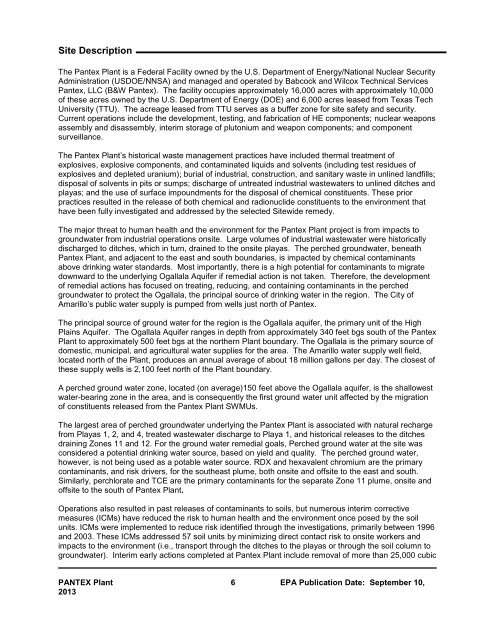PANTEX PLANT - US Environmental Protection Agency
PANTEX PLANT - US Environmental Protection Agency
PANTEX PLANT - US Environmental Protection Agency
You also want an ePaper? Increase the reach of your titles
YUMPU automatically turns print PDFs into web optimized ePapers that Google loves.
Site Description<br />
The Pantex Plant is a Federal Facility owned by the U.S. Department of Energy/National Nuclear Security<br />
Administration (<strong>US</strong>DOE/NNSA) and managed and operated by Babcock and Wilcox Technical Services<br />
Pantex, LLC (B&W Pantex). The facility occupies approximately 16,000 acres with approximately 10,000<br />
of these acres owned by the U.S. Department of Energy (DOE) and 6,000 acres leased from Texas Tech<br />
University (TTU). The acreage leased from TTU serves as a buffer zone for site safety and security.<br />
Current operations include the development, testing, and fabrication of HE components; nuclear weapons<br />
assembly and disassembly, interim storage of plutonium and weapon components; and component<br />
surveillance.<br />
The Pantex Plant’s historical waste management practices have included thermal treatment of<br />
explosives, explosive components, and contaminated liquids and solvents (including test residues of<br />
explosives and depleted uranium); burial of industrial, construction, and sanitary waste in unlined landfills;<br />
disposal of solvents in pits or sumps; discharge of untreated industrial wastewaters to unlined ditches and<br />
playas; and the use of surface impoundments for the disposal of chemical constituents. These prior<br />
practices resulted in the release of both chemical and radionuclide constituents to the environment that<br />
have been fully investigated and addressed by the selected Sitewide remedy.<br />
The major threat to human health and the environment for the Pantex Plant project is from impacts to<br />
groundwater from industrial operations onsite. Large volumes of industrial wastewater were historically<br />
discharged to ditches, which in turn, drained to the onsite playas. The perched groundwater, beneath<br />
Pantex Plant, and adjacent to the east and south boundaries, is impacted by chemical contaminants<br />
above drinking water standards. Most importantly, there is a high potential for contaminants to migrate<br />
downward to the underlying Ogallala Aquifer if remedial action is not taken. Therefore, the development<br />
of remedial actions has focused on treating, reducing, and containing contaminants in the perched<br />
groundwater to protect the Ogallala, the principal source of drinking water in the region. The City of<br />
Amarillo’s public water supply is pumped from wells just north of Pantex.<br />
The principal source of ground water for the region is the Ogallala aquifer, the primary unit of the High<br />
Plains Aquifer. The Ogallala Aquifer ranges in depth from approximately 340 feet bgs south of the Pantex<br />
Plant to approximately 500 feet bgs at the northern Plant boundary. The Ogallala is the primary source of<br />
domestic, municipal, and agricultural water supplies for the area. The Amarillo water supply well field,<br />
located north of the Plant, produces an annual average of about 18 million gallons per day. The closest of<br />
these supply wells is 2,100 feet north of the Plant boundary.<br />
A perched ground water zone, located (on average)150 feet above the Ogallala aquifer, is the shallowest<br />
water-bearing zone in the area, and is consequently the first ground water unit affected by the migration<br />
of constituents released from the Pantex Plant SWMUs.<br />
The largest area of perched groundwater underlying the Pantex Plant is associated with natural recharge<br />
from Playas 1, 2, and 4, treated wastewater discharge to Playa 1, and historical releases to the ditches<br />
draining Zones 11 and 12. For the ground water remedial goals, Perched ground water at the site was<br />
considered a potential drinking water source, based on yield and quality. The perched ground water,<br />
however, is not being used as a potable water source. RDX and hexavalent chromium are the primary<br />
contaminants, and risk drivers, for the southeast plume, both onsite and offsite to the east and south.<br />
Similarly, perchlorate and TCE are the primary contaminants for the separate Zone 11 plume, onsite and<br />
offsite to the south of Pantex Plant.<br />
Operations also resulted in past releases of contaminants to soils, but numerous interim corrective<br />
measures (ICMs) have reduced the risk to human health and the environment once posed by the soil<br />
units. ICMs were implemented to reduce risk identified through the investigations, primarily between 1996<br />
and 2003. These ICMs addressed 57 soil units by minimizing direct contact risk to onsite workers and<br />
impacts to the environment (i.e., transport through the ditches to the playas or through the soil column to<br />
groundwater). Interim early actions completed at Pantex Plant include removal of more than 25,000 cubic<br />
<strong>PANTEX</strong> Plant 6 EPA Publication Date: September 10,<br />
2013
















